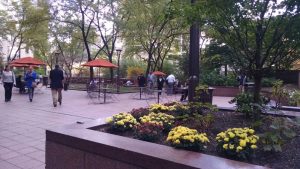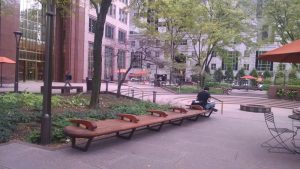by Amanda L. Miller & Rachel C. Palisin — This article originally appeared in the July/August 2020 issue of FMJ
Constantly exposed to the elements, plazas will eventually succumb to time and weather, requiring increasingly involved maintenance practices to keep the space safe and orderly. As the demands of upkeep become greater and the plaza appearance grows worn and dated, rehabilitation is the next step to refresh and re-envision the space through modernization and performance improvements.
Together, the design team, building owners and facility managers can place the principles of access, maintainability, and lifespan at the forefront of the design process to create an inviting, attractive and resilient plaza space. With thorough evaluation of plaza programming and caretaking practices, the team can develop a design that enhances durability and promotes longevity by addressing sustainability, efficiency, and ease of maintenance. The long-term impact of materials, accessibility, structural capacity and water management decisions will result in a plaza that is both aesthetically pleasing at installation and continues to perform with an enduring beauty for many years to come.
Upgrade Considerations
In preparation for a plaza rehabilitation project, the design team and FM should evaluate the benefits and drawbacks of the existing plaza. Considering the following initial elements creates an opportunity to plan for improvements, enrich the design and prepare for maintenance over the long term.
Historic/Landmark/Zoning Status
Determine if the plaza contributes to the historic quality of a place or context. Is the space recognized as a landmark by local, state, or national jurisdictions? Is the space considered public or private and are there zoning regulations? These conditions require sensitivity in the case of potential restrictions for material selection and reconfiguration.
Users and Operating Hours
Identify the current users of the plaza and activities within the space. Is the plaza open and used year-round? Do the use patterns change with the seasons? Are there daily operating hour restrictions? Is the plaza open to the public or is access limited?
Layout
Interpret the existing arrangement of the plaza based on the identified use and function. Does the current configuration allow for the flow of pedestrian or vehicular traffic? How does the plaza relate to entrances, desire paths and sightlines? Can the plaza accommodate specialized requirements, such as for electrical or audio-visual needs?
Landscape
Assess how the plaza and landscape complement each other. Are there existing landscape elements to preserve, such as mature trees? To what extent is shade and/or sunlight desirable? Is the landscape integral to diverting or filtering surface water? Are plantings drought-tolerant or native to the climate and location?
Maintenance
Establish who is responsible for maintenance of the plaza. Does dedicated staff take care of daily, weekly, or annual upkeep? How is debris and snow removal handled? Will the landscape require seasonal care and watering?
Performance, Access, and Longevity
Based on the initial evaluation, the design should also address the need to be accessible, durable both through install and maintenance, and functional over the long term. Layout and construction decisions start with vetting material selection, assessing system performance and designing for adequate drainage. Furthermore, to the greatest extent possible, and as mandated by regulations, barrier-free access to plaza areas and building entrances must be provided.
Material and System Performance
Plazas are subjected to all types of exposure and must be durable as well as maintainable. From the setting bed and base to the finished surface, the selected materials will address functional needs while also contributing to the aesthetic spatial experience.
Determining the elements of the assembly combines an understanding of existing conditions and anticipated usage. At on-grade plazas, soil composition and susceptibility to frost heave may make foundations extending to the frost line desirable to resist the movement associated with freeze-thaw cycles. Typical plaza construction includes an aggregate base, often topped with concrete or asphalt and finished with a sand, bituminous or mortar setting bed for pavers. Depending on the expected traffic types, the foundation and finish surface must be able to support the anticipated and building code-mandated loads. For plazas or terraces over occupied space, loading is an even more significant structural concern, in addition to integration with the building envelope system.
The finish surface, commonly stone, clay pavers, concrete or asphalt, is both performance-based and aesthetic. The chosen material must be slip- and skid-resistant, based on the anticipated pedestrian and/or vehicular traffic. Furthermore, the coloration and reflectivity of the paving surface will directly contribute to the heat island effect. Environmental conditions also contribute to material lifespan. Saline environments and products including residue from deicing salts, can cause accelerated degradation of materials, and may result in efflorescence or staining. Snow removal blades or materials spread to provide traction can also chip the paving surface or cause excessive wearing.
The joint size and system, including provisions for expansion and control joints, accommodates differential movement and finished surface continuity. Routine maintenance may degrade the joints, allowing pavers to easily displace. For example, sand-swept joints, while resilient and easily maintained, are less resistant to aggressive cleaning techniques such as pressure washing. In areas with pedestrian or wheeled traffic, the bonding pattern should be oriented perpendicular to movement where possible, as large joints may result in stuck wheels or heels. Interlocking patterns, such as a herringbone, can also more effectively distribute loads.
In combination, the specific paving material and joint system can create both vibrant and subtle effects. From the consistency of a manufactured paver, to the nuance of variegated and multi-textured brick, to the striking veining of natural stones, the range of scales, sizes and orientation of pavers can create an expansive set of styles to reflect the aesthetic context of the plaza.
Accessibility
Along with material and system selection challenges, the rehabilitation of existing plazas creates an opportunity for greater access, usability, and potential for new connections between areas that were previously not accessible. Starting with the Americans with Disabilities Act (ADA) in 1990, the United States Department of Justice regulates and enforces accessibility mandates. These standards are codified in the 2010 ADA Standards for Accessible Design. Model building codes, such as the International Building Code (IBC) and the referenced ICC/ANSI A117.1 Accessible and Usable Buildings and Facilities, are harmonized with the 2010 ADA Standards for Accessible Design and include requirements for the topics discussed in this section.
Slip resistance and stable, firm ground surfaces are necessary for safe navigation of walking surfaces. In an exterior environment, surface contaminants, such as oils and water, can reduce the frictional counterforce of a material. Sound walking surfaces also demand that floor surface openings such as gratings be limited to less than a half-inch in width and oriented with the longest edge perpendicular to the direction of travel. Smaller openings, such as a quarter inch, may be specified for “heel-proof” applications.
Site gradient will also significantly impact the design for access. The grading of plaza walking surfaces should not exceed a slope of 1:20 (5 percent) or a cross slope of 1:48 (2 percent).
In order to improve access across a site or to parking areas or building entrances, regrading is often part of plaza rehabilitation. A combination of stairs, ramps and handrails can be used to address connectivity. Based on evaluation of the existing layout, a similar or equivalent experience should be provided for users of stairs and ramps. If these assemblies are part of the means of an egress system, further study must be given to the occupancy load and associated egress capacity.
Stair, ramp and handrail design requirements are closely detailed by the 2010 ADA Standards and ICC/ANSI A117.1, as well as local building codes. The following are key considerations during the initial design phase:
Clear space must be provided at stair and ramp landings as well as doors. In addition to clear space, 60-inch diameter turning spaces are required at directional changes in the ramp or where the user would be required to turn around due to the presence of an obstacle, such as a locked door.
Stair pitch is mandated by local building codes; in commercial applications, pitch is typically a maximum of 7:11. More gradual pitches are acceptable but should be carefully considered to address user comfort. A handy rule of thumb recommends the height of two risers plus one tread depth should equal 25 inches.
Ramp slope should generally not exceed 1:12, with limited exceptions, and the clear width should not be less than 36 inches between the handrails.
Handrails on both sides of stairs and ramps are typically required by code, with minimum and maximum cross-sections for ease of use. If the rise of the stair or ramp exceeds 30 inches from the adjacent grade, guardrails will also need to be provided. Local building codes will specify structural performance and dimensional requirements.
Handrails and guardrails can vary greatly in material and design. Given their essential purpose in mobility assistance and fall protection, durability and maintainability are of utmost importance. A variety of metals, such as aluminum, bronze, stainless steel or carbon steel, are typically specified and can be finished with paint, anodized or allowed to patinate. Similar materials are also used for infill, in mesh, perforated or woven form, as well as glass.
Water Management
Drainage is a significant design concern, as unmanaged water is often the cause of maintenance problems. Water can be categorized as surface water, such as rainfall or runoff from impervious surfaces, and subsurface water, including aquifers or high-water tables. Both must be accounted for in the drainage system and addressed through design, layout and material choices.
Keeping in mind potential water sources, the existing drainage system from inlet, to catch basin, to outlet piping should be assessed. Where there are known drainage issues, video inspection may be beneficial to determine if blockages are present and if hydrojet cleaning should be recommended. Depending on the condition of the system, replacement of elements such as piping may be required.
Permeable or impermeable finish materials, jointing, setting bed and base selections will affect how water flows through or is redirected from the plaza surface. The existing system may need supplementary drains or modifications, including new surface drains, catch basins, dry wells, detention or retention ponds, as well as reconfiguration of the pitch and orientation of the finished surface. As with accessibility, the plaza gradient may require modification. Coordinating the positive flow of water to drains reduces potential areas for ponding water, which can cause staining, maintenance issues and accumulation of ice in the winter months.
All new elements must be connected to the existing storm system and comply with local regulations for stormwater management. Selected drain covers should prevent detritus from entering the system and provide easy access for cleaning and debris removal from collection baskets. Finally, planters, fountains and other unique fixed site features that could impede drainage or may require their own internal drainage must be coordinated with the overall water management design.
Site Furnishings and Amenities
In addition to the design of the ground plane, plazas often feature elements to enhance usability, interest and foster a variety of experiences. Water features and landscaping can create a cooler microclimate and add ambience. Shade elements, such as trees and awnings, provide protection from the sun during summer months.
Permanent, fixed furniture can be designed or specified from a variety of manufacturers whose offerings include metal, concrete, wood or plastic products. The selection should weigh aesthetic qualities alongside durability, including resistance to weather and vandalism, as well as available storage on site. Trash disposal should also be accounted for, with discreet receptacles provided according to a waste management plan.
Lighting and provisions for power or audio can allow for greater flexibility in plaza programming and hours of use. Illumination includes general lighting, as well as accent lighting of landscaping and/or pathways. Innovations in exterior lighting include attractive designs to minimize light pollution, improve energy efficiency and upgrade existing fixtures to long-lasting LED units.
All these features and amenities, while providing opportunities to increase the vitality and life of the plaza, require coordination with the overall design performance, particularly when addressing maintenance, accessibility, safety and water management.
Key Design Considerations
Design decisions have lasting implications around plaza care and maintenance to sustain function and usability of the rehabilitated plaza.
Snow and Ice Management
Consider adding a hydronic or electric snow melt system to simplify maintenance in the winter months. Chlorides used in snow removal, snow removal blades or blowers can quickly degrade material surfaces and impact plaza longevity. A plan for snow disposal and/or storage should also be established.
Landscaping Choices
Capacity for long-term plant care, including pruning, fertilization and supplementation should be part of the plant selection process. Access and equipment required for upkeep, such as grasses that require mowing, will be an ongoing concern. Irrigation systems demand maintenance, including cleaning and potentially, winterization.
Debris Removal
Plan for ease when performing frequent and routine tasks, from clearing drains to keeping joints free from weeds. This will reduce the time and expense of maintenance activity. For elevated plazas and terraces, fall protection measures may need to be included to permit safe access.
Maintenance of Fixtures and Finishes
Bulb replacement, repainting, furniture repair and other tasks that keep the plaza well-lit and secure are integral to function and appearance. Durable fixtures with long lifespans mean less maintenance. However, maintenance is inevitable; so, selecting fixtures that are designed for easy access and repair will make the process even more seamless.
Rehabilitation for Long-term Maintenance
Plaza upgrades are an opportunity to provide safe and convenient access for people of all ages and ability, enhance amenities and add dimension to an existing space, while simultaneously improving performance and reducing maintenance costs. Time and attention to the selection, design and installation of paving and drainage systems can have a substantial impact on the durability and maintainability of the plaza, which in turn impacts the aesthetic and functional performance of the space and its value as a building amenity. For plazas over occupied space, structural concerns are also central to the design process. With planning that considers immediate needs alongside the long-term demands of the space, a plaza project can create a desirable feature that serves as an asset not only to the building owner and occupants, but to the greater community.
About the Authors
 Amanda L. Miller, AIA, is senior staff architect with Hoffmann Architects in New York. After completing a master’s degree in design studies at the Harvard University Graduate School of Design, Miller organized the Harvard Black in Design Conference and was selected for the AIA New York Civic Leadership program. She develops design solutions for plazas that promote accessibility and enhance performance.
Amanda L. Miller, AIA, is senior staff architect with Hoffmann Architects in New York. After completing a master’s degree in design studies at the Harvard University Graduate School of Design, Miller organized the Harvard Black in Design Conference and was selected for the AIA New York Civic Leadership program. She develops design solutions for plazas that promote accessibility and enhance performance.
 Rachel C. Palisin, P.E., LEED AP, is senior engineer with Hoffmann Architects, Inc., an architecture and engineering firm specializing in the rehabilitation of building exteriors. An experienced professional engineer with a master’s degree in structural engineering from Washington University in St. Louis, Missouri, USA, she leads a team of technical staff in meeting the structural engineering challenges of plaza and building enclosure projects in the New York metropolitan area.
Rachel C. Palisin, P.E., LEED AP, is senior engineer with Hoffmann Architects, Inc., an architecture and engineering firm specializing in the rehabilitation of building exteriors. An experienced professional engineer with a master’s degree in structural engineering from Washington University in St. Louis, Missouri, USA, she leads a team of technical staff in meeting the structural engineering challenges of plaza and building enclosure projects in the New York metropolitan area.



